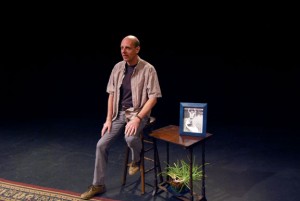
As a touching autobiographical account, the play brings tricky classifications like boyfriend, pedophile, lover and molester into perspective. It follows Marty Moran’s tale of growing up as a Catholic schoolboy in the 1970s. He opens with entertaining jokes about school nuns, saints and public school kids. He goes on to describe how the clergy sex scandal surfaced while his inappropriate relationship with Bob, his former camp counselor, began.
Director Sara Lampert Hoover’s set consists only of a large living room rug, a wooden stool with a leather cover and an end table. A potted plant sits on the bottom with a framed photograph of his 12-year-old self on top. This minimalist approach, coupled with E.D. Intemann’s simple but effective lighting, complements the difficult material.
The play begins with actor Carl Danielsen walking on stage as Moran and grabbing the stool. He breaks the fourth wall, conversing with the audience about topics discussed in Artistic Director Rachel Lampert’s pre-show speech. It is impossible to tell what is the script and what is improvisation for the first 10 minutes. All of the house lights remain on and fully up.
While Moran usually plays himself in “The Tricky Part,” Danielsen plays the part well. His stories alternate between adolescent memories and a visit with Bob at the veterans’ hospital 35 years later. His depiction of his first sexual partner is particularly superb. With his fingers in his belt loop, a slouched stance and his right foot out, he transforms seamlessly into Bob. Moran’s realistic and incredibly detailed descriptions combine with the fear and insecurity Danielsen shows through his expressive tones, speech and facial expressions.
The best moment comes about three-quarters through the play, when the full lights fade out to one spotlight engulfing Danielsen. He reads from his journal in a campfire-like moment about his first sexual experience with Bob. The story becomes an out-of-body experience for viewers. They feel the same unease and forbidden interest Moran had the first time Bob slipped his hand into the adolescent’s underwear. Danielsen handles this material perfectly. He stays completely serious, with the interest and fear of the 12-year-old and the disgust and maturity of his older self. He also navigates the treacherous waters of Bob as his father figure. He discusses how he looked toward Bob for guidance and admits he was a major influence on his life.
Certain elements of “The Tricky Part” leave more to be desired. Mentions of his early homosexual love interests, his suicide attempts at 15 and 16 after Bob’s imprisonment for his relationship with another boy and his sexual compulsiveness in adulthood tantalize with their dramatic appeal. But, they serve only as secondary plot. Though the writing is strong, the nearly two hours of Danielsen walking and talking leaves a desire for more dramatic action or movement of some kind.
Danielsen refers to the photo sitting on the table near the play’s end. He says the smiling shot of that young boy holding a kayak paddle proudly over his head was taken only a few weeks after his first night with Bob. As the show wraps up, he explains that he cannot hate Bob forever. While Bob almost made Moran take his own life twice, he also taught him how to be a man. This is the catch — the tricky part — for Moran, who grew up with a socially unacceptable relationship as a child, which influenced who he became as an adult.
“The Tricky Part” will play through April 10 at the Kitchen Theatre. Student tickets are $26, and adult tickets are $28.
3 out of 4 stars




